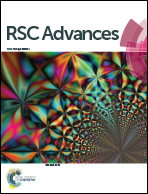Stable and reversible doping of graphene by using KNO3 solution and photo-desorption current response†
Abstract
Graphene is easily p-doped by various impurities. Thus, finding a stable method of the n-doping of graphene is highly necessary for device fabrication. In this paper, the stable n-doping and charge carrier mobility improvement of chemical vapor deposition (CVD)-grown graphene by using KNO3 solution were reported. Electron doping effect was examined by electrical transport measurement and Raman spectroscopy, and results suggested that the n-doping mechanism was due to ionic physisorption on graphene surface. The stable doping of graphene in atmospheric environment and at various temperatures (300, 50, 25, and 4.7 K) was also found. The n-doping effect was lifted and the charge neutrality point of doped graphene was restored to its initial state after annealing in Ar environment. Furthermore, the photo-desorption behavior of KNO3-treated graphene under deep ultraviolet light was studied. Treatment by KNO3 weakened the photo-desorption effect of CVD-grown graphene. This weakening effect was ascribed to the reduction of oxygen constituents on graphene surface, as further confirmed by X-ray photoelectron spectroscopy. The chemical doping method using KNO3 solution provided a novel route to the n-doping of graphene for the realization of high-performance graphene-based electronic devices.


 Please wait while we load your content...
Please wait while we load your content...